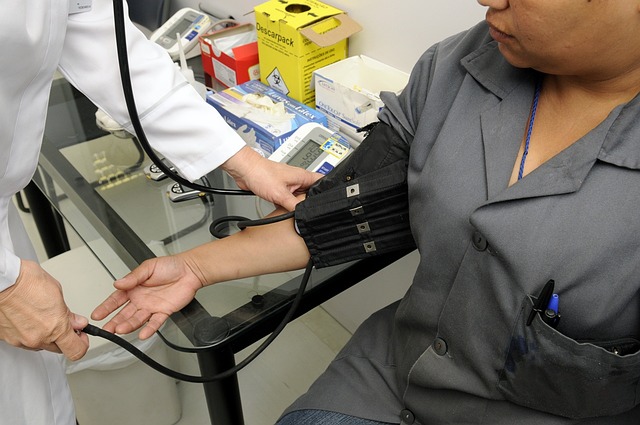Post-traumatic stress disorder (PTSD) is a mental health condition triggered by traumatic events, with symptoms like flashbacks, nightmares, and avoidance behaviors. Early intervention is crucial as causes vary widely. Effective PTSD treatments include cognitive behavioral therapy (CBT), eye movement desensitization and reprocessing (EMDR), exposure therapy, mindfulness-based approaches, group therapy, medication for co-occurring conditions, and alternative therapies like art, music, and movement. Building resilience through CBT, support groups, mindfulness, and exposure therapy is vital for long-term recovery.
Post-Traumatic Stress Disorder (PTSD) is a complex mental health condition affecting millions. This article explores comprehensive therapeutic approaches for PTSD, offering a roadmap to healing. From evidence-based modalities like Cognitive Behavioral Therapy (CBT) and Eye Movement Desensitization and Reprocessing (EMDR), to innovative practices such as exposure therapy, mindfulness techniques, group support, and alternative therapies, each section delves into effective strategies. Discover how these methods empower individuals to overcome PTSD, foster resilience, and achieve lasting recovery.
Understanding PTSD: Symptoms and Causes

Post-traumatic stress disorder (PTSD) is a mental health condition that can occur after someone experiences or witnesses a traumatic event. Understanding the symptoms and causes of PTSD is crucial for effective therapeutic approaches. The most common symptoms include flashbacks, nightmares, and severe anxiety, often triggered by reminders of the trauma. Individuals with PTSD may also experience emotional numbness, avoidance behaviors, and heightened irritability.
Causes of PTSD are varied, with exposure to life-threatening events such as combat, accidents, natural disasters, or violent crimes being primary triggers. Prolonged or intense stress can lead to the development of PTSD, underscoring the importance of early intervention and appropriate treatment. Effective PTSD treatment involves a range of therapeutic approaches, including cognitive behavioral therapy (CBT), eye movement desensitization and reprocessing (EMDR), and trauma-focused supportive counseling, aimed at helping individuals process and overcome their traumatic experiences.
Cognitive Behavioral Therapy (CBT) for PTSD

Cognitive Behavioral Therapy (CBT) is a widely recognized and effective therapeutic approach for Post-Traumatic Stress Disorder (PTSD). This evidence-based method focuses on identifying and modifying unhelpful thought patterns, behaviors, and emotional responses associated with traumatic experiences. CBT helps individuals with PTSD gain a more balanced perspective of the traumatic event(s), reducing the intense emotions and physical reactions that can be triggered by reminders or memories.
Through structured sessions, CBT enables patients to challenge negative beliefs and replace them with realistic, positive thoughts. It also teaches coping strategies for managing anxiety, depression, and other symptoms commonly associated with PTSD. By learning these skills, individuals can better navigate their daily lives, reduce the impact of traumatic memories, and improve overall well-being. This form of therapy offers a practical and goal-oriented path to healing and recovery for those struggling with PTSD.
Eye Movement Desensitization and Reprocessing (EMDR)

Eye Movement Desensitization and Reprocessing (EMDR) is a well-established therapeutic approach for Post-Traumatic Stress Disorder (PTSD). This method combines guided eye movements or other bilateral stimulation with recall of traumatic memories, aiming to help individuals process and reduce the intensity of these memories. The theory behind EMDR suggests that traumatic events can disrupt the brain’s natural information processing, leading to symptoms like flashbacks, nightmares, and avoidance behaviors. By reintroducing and reprocessing these memories in a safe environment, patients can gain a new perspective on their trauma and experience significant relief from associated symptoms.
EMDR therapy is known for its ability to offer rapid results, often reducing the severity of PTSD symptoms within just a few sessions. It has been extensively researched and recognized as an effective treatment by various mental health organizations worldwide. This approach allows individuals to confront and re-experience traumatic memories while simultaneously focusing on positive beliefs, thereby fostering resilience and promoting healing. Through this process, patients can learn to manage their responses to traumatic reminders and regain control over their lives.
Exposure Therapy: Facing Fear to Overcome PTSD

Exposure therapy is a powerful and effective PTSD treatment approach that focuses on helping individuals confront and overcome their fears. By gradually exposing patients to traumatic memories or situations in a safe, controlled environment, therapists enable them to process and manage their responses to these triggers. This process involves facing and re-experiencing the trauma, which helps to reduce the intensity of emotional reactions over time.
Through exposure therapy, individuals with PTSD can learn coping strategies and gain a sense of control as they realize that their feared situations are not as dangerous as their minds have led them to believe. This approach has been widely recognized as an evidence-based method for treating PTSD, offering lasting results in many cases. It empowers people to take back power from their traumatic experiences and live more fulfilling lives.
Mindfulness-Based Approaches to Healing PTSD

Mindfulness-based approaches have emerged as powerful tools in the realm of PTSD treatment, offering a gentle and effective way to heal. These methods encourage individuals to focus on the present moment, non-judgmentally, allowing them to observe their thoughts and emotions without getting overwhelmed. Techniques like mindfulness meditation, deep breathing exercises, and yoga can help reduce the intensity of traumatic memories and flashbacks, promoting a sense of calm.
By fostering awareness of bodily sensations and thoughts, individuals with PTSD can develop a healthier relationship with their experiences. This proactive approach enables them to navigate triggers more effectively and respond rather than react, ultimately enhancing their overall well-being. Research supports the positive impact of mindfulness on PTSD symptoms, making it an integral part of many modern therapy modalities.
Group Therapy: The Power of Connection in PTSD Treatment

Group therapy offers a powerful therapeutic approach for individuals suffering from Post-Traumatic Stress Disorder (PTSD). By coming together in a supportive and structured setting, those affected by trauma can find solace and healing. The power of connection lies at the heart of its effectiveness; sharing experiences and emotions with peers who understand can reduce feelings of isolation and promote a sense of belonging. This collective support network allows individuals to challenge negative beliefs and thoughts associated with their traumatic memories.
In group therapy sessions, participants engage in various activities, such as discussion forums, mindfulness exercises, and exposure therapy techniques, all aimed at helping them process and overcome their PTSD symptoms. The shared journey towards healing fosters a sense of community, where members encourage and uplift each other. This collective experience can be transformative, offering new perspectives on coping strategies and encouraging individuals to face their fears in a safe and supportive environment.
Medication Options for Co-occurring Disorders with PTSD

Many individuals living with post-traumatic stress disorder (PTSD) also experience co-occurring mental health conditions, such as anxiety, depression, or substance use disorders. In such cases, a comprehensive treatment approach that addresses both PTSD and the co-occurring disorder is essential for effective healing. Medication options play a significant role in managing these dual diagnoses.
Selective serotonin reuptake inhibitors (SSRIs) and sertraline are commonly prescribed for PTSD as they can help reduce symptoms of anxiety and depression while regulating serotonin levels in the brain. For individuals with substance use disorders, medication-assisted treatment (MAT) combines medications like buprenorphine or methadone with therapy to manage cravings and withdrawal symptoms, offering a more holistic approach to PTSD treatment tailored to those with complex mental health needs.
Alternative Therapies: Art, Music, and Movement for PTSD Relief

Art, music, and movement therapies offer alternative yet powerful approaches for individuals seeking PTSD treatment. These creative methods provide a unique avenue for expression and healing by engaging the mind and body in novel ways. For example, art therapy allows people to visually represent their experiences and emotions through painting, drawing, or sculpting, helping them process traumatic memories in a safe and controlled manner. Similarly, music therapy harnesses the emotional power of sound, using both active and passive engagement with music to regulate mood and stimulate healing.
Movement therapies, such as dance/movement therapy, yoga, and mindfulness-based exercises, focus on the body’s inherent wisdom to facilitate recovery. These practices help individuals reestablish a sense of control over their bodies, improve emotional regulation skills, and foster a deeper connection between mind and body, all of which contribute to PTSD relief. By tapping into these alternative therapies, individuals can complement traditional treatments and potentially find new ways to navigate and overcome the challenges associated with PTSD.
Building Resilience and Coping Strategies for Long-Term Recovery

Building resilience is a cornerstone in long-term recovery for individuals dealing with Post-Traumatic Stress Disorder (PTSD). Therapeutic approaches focus on empowering individuals to cope with distressing memories and emotions associated with their trauma. Techniques such as cognitive behavioural therapy (CBT) teach effective coping strategies, helping individuals challenge negative thoughts and beliefs that may have developed after traumatic events. By replacing these unhelpful thought patterns with more realistic and positive ones, individuals can gradually reduce the intensity of PTSD symptoms.
Support groups, mindfulness practices, and exposure therapy are also valuable tools in building resilience. Support groups provide a safe space for sharing experiences and learning from others who have faced similar challenges. Mindfulness encourages present-moment awareness, enabling individuals to detach from intrusive thoughts and emotions related to past traumas. Exposure therapy, under professional guidance, gradually exposes individuals to traumatic memories or triggers in a controlled environment, helping them process and overcome their fears over time. These strategies collectively contribute to fostering resilience, enhancing coping abilities, and promoting long-term recovery for those with PTSD.
